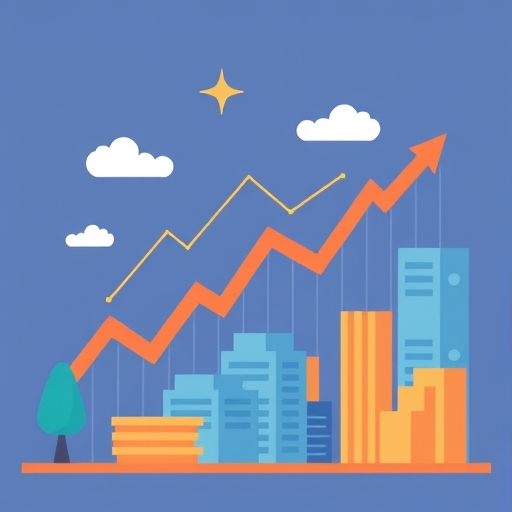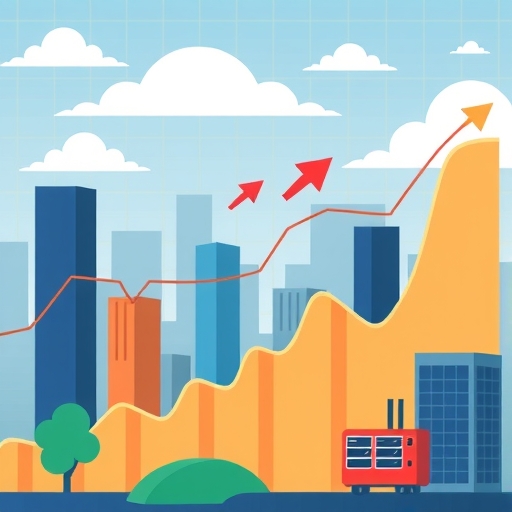Commodity Price Indices: Your Portfolio’s Essential Shield Against Inflation and Volatility
Are you looking for ways to protect your investments from the unpredictable shifts of the global economy, especially the persistent challenge of inflation? While stocks and bonds are common building blocks for any investment portfolio, the world of commodity price indices offers a powerful, often overlooked, avenue for diversification and resilience. In this article, we will embark on a journey to understand what commodity price indices are, how they evolved, and why they can be an indispensable tool for enhancing your investment strategy. We’ll explore their unique ability to act as a hedge against rising prices and provide valuable diversification, ultimately helping you build a more robust financial future.
Decoding Commodity Indices: Structure, Components, and Investment Accessibility
So, what exactly is a commodity price index? Imagine a basket filled with various raw materials like crude oil, gold, wheat, and copper. A commodity price index is essentially a weighted average of the prices of these selected commodities. It’s designed to track the performance of either a broad category of raw materials or a more specific group, such as just energy products or precious metals. Think of it like a stock market index, such as the S&P 500, but instead of tracking company shares, it tracks the prices of physical goods that are bought and sold globally.
Understanding the distinction between spot and futures prices is crucial when analyzing commodity indices. While spot prices reflect immediate delivery, futures prices, which are more commonly used in investable indices, reflect expectations for future supply and demand.
| Feature | Spot Price | Futures Price |
|---|---|---|
| Definition | Price for immediate delivery of a commodity. | Price agreed upon today for delivery of a commodity at a future date. |
| Delivery | Immediate or very near-term. | Specific future date (e.g., 1 month, 3 months, 1 year). |
| Influence | Current supply/demand, immediate events. | Expectations of future supply/demand, storage costs, interest rates. |
| Usage in Indices | Less common for investable indices due to logistical challenges. | Dominant for investable commodity indices, providing broader market exposure. |
These indices can be based on either spot prices (the immediate price for a commodity) or, more commonly for investable indices, futures prices (prices for commodities to be delivered at a future date). By tracking a basket of commodities, the index gives us a clear picture of how this asset class is performing overall.  For you, the investor, this means gaining exposure to commodities without the complexities of directly buying and storing physical goods or navigating the intricate futures markets. Instead, you can gain passive exposure through financial instruments like total return swaps or commodity index funds, which are often traded on exchanges, making them much easier to access.
For you, the investor, this means gaining exposure to commodities without the complexities of directly buying and storing physical goods or navigating the intricate futures markets. Instead, you can gain passive exposure through financial instruments like total return swaps or commodity index funds, which are often traded on exchanges, making them much easier to access.
Why would you consider adding commodities to your portfolio? The primary advantages are twofold: negative correlation with other asset classes and protection against inflation. Unlike stocks and bonds, commodities often move in the opposite direction, or at least differently, during certain economic conditions. When inflation rises, the cost of raw materials typically increases, which can boost the value of commodity investments, thereby acting as a natural hedge for your purchasing power. However, it’s not without its challenges. One significant disadvantage can be negative roll yield, especially in a market condition known as contango, where future prices are higher than current spot prices. This can be a drag on returns, but active management techniques can sometimes help mitigate this effect.
Investors can gain exposure to commodity indices through various financial instruments, each with its own characteristics:
- Exchange-Traded Funds (ETFs): These funds hold contracts that track commodity indices, offering liquid and easy access for retail investors.
- Exchange-Traded Notes (ETNs): Debt instruments that track the performance of a commodity index, but carry issuer credit risk.
- Mutual Funds: Some mutual funds specialize in commodity investments, providing professional management and diversification across multiple commodities.
- Total Return Swaps: More complex instruments typically used by institutional investors to gain synthetic exposure to an index’s performance.
From Pioneering Beginnings to Modern Benchmarks: A Historical Journey
The journey of commodity price indices from academic concepts to widely investable benchmarks is quite fascinating. The idea of tracking commodity futures dates back nearly a century. The Dow Jones Futures Index, established in 1933 (with data backfilled to 1924), was one of the earliest attempts to measure the performance of commodity futures. This laid the groundwork for future developments. 
Fast forward to 1958, and we saw the emergence of the CRB Index (Commodity Research Bureau Index), which became a foundational benchmark for tracking a diverse set of commodities. However, it was the introduction of the Goldman Sachs Commodity Index (GSCI) in 1991 that truly made commodity investment practical and accessible for institutional investors. The GSCI, now known as the S&P GSCI after S&P Dow Jones Indices took over its administration, quickly became a leading indicator of broad commodity performance, with a significant weighting towards energy commodities.
Another pivotal development was the Dow Jones AIG Commodity Index, later rebranded as the Bloomberg Commodity Index (BCOM). This index introduced innovative mechanisms aimed at limiting the weight of any single commodity, promoting greater diversification within the index. We also saw important academic contributions, such as the influential 2005 paper “Facts and Fantasies About Commodities Futures” by Gary Gorton and Geert Rouwenhorst. Their research shed light on the unique relationships between commodity indices, stock markets, and inflation, further solidifying the academic and investment case for commodities. These historical milestones highlight a continuous evolution towards more sophisticated, transparent, and investable commodity benchmarks.
Throughout history, several key commodity indices have played a crucial role in shaping the understanding and accessibility of commodity markets for investors:
| Index Name | Year Introduced | Primary Focus/Significance |
|---|---|---|
| Dow Jones Futures Index | 1933 (data to 1924) | One of the earliest attempts to measure commodity futures performance. |
| CRB Index | 1958 | A foundational benchmark for tracking a diverse set of commodities. |
| S&P GSCI (formerly Goldman Sachs Commodity Index) | 1991 | Made commodity investment practical for institutional investors; significant energy weighting. |
| Bloomberg Commodity Index (BCOM, formerly DJ-AIGCI) | Introduced mechanisms for greater diversification, limiting single commodity weight. | Pivotal in promoting diversification within commodity indices. |
Beyond Equities and Bonds: Why Commodities Offer Unique Portfolio Protection
Why should you, as an investor, seriously consider adding commodities to your portfolio, especially when traditional investments feel uncertain? The answer lies in their distinctive investment benefits, primarily their role as an inflation hedge and their ability to provide powerful diversification. We’ve touched on this, but let’s delve deeper. 
When the cost of living goes up, meaning inflation is present, your dollar simply buys less. This erodes the purchasing power of your savings and investments. Commodities, as the raw materials that go into almost everything we buy, tend to increase in value during inflationary periods. This is a direct correlation: as the price of energy, food, and metals rises, so too does the value of the commodity indices tracking them. This makes commodities a potent buffer for your portfolio, helping to maintain your real returns when inflation is high. Recent market performance clearly illustrates this; commodities have delivered strong performance, including double-digit returns, often outperforming traditional asset classes like stocks and bonds in certain periods.
Furthermore, commodities offer what we call negative correlation or low correlation with other major asset classes. What does this mean for your portfolio? While stocks and bonds often move in the same general direction, commodities tend to march to the beat of a different drum. For example, during times of economic slowdown or geopolitical tension, stocks might fall, but certain commodities, like gold, might rise as investors seek safe havens. This independent movement helps to smooth out your overall portfolio returns. When one part of your portfolio is down, another might be up, reducing overall volatility and enhancing your investment resilience. This diversification isn’t just a theory; it’s a proven strategy for building a more stable and robust investment portfolio over the long term.
Diversifying your investment portfolio with commodity indices can offer several strategic advantages:
- Reduced Portfolio Volatility: By combining assets that don’t move in lockstep, overall portfolio swings can be dampened.
- Improved Risk-Adjusted Returns: Diversification can lead to higher returns for a given level of risk, or lower risk for a given level of return.
- Capital Preservation: During periods when traditional assets underperform, commodities can help protect capital.
- Enhanced Long-Term Performance: A well-diversified portfolio is generally more resilient to various economic cycles.
The Engineering of Indices: Methodologies, Rebalancing, and Resilience
Have you ever wondered what goes into building a commodity price index? It’s far more complex than simply averaging a few prices. Index providers employ sophisticated methodologies to ensure these benchmarks are representative, robust, and reliable. Commodities within indices are broadly categorized, reflecting their economic significance. The main groups include:
- Energy: Think crude oil, natural gas, heating oil, and unleaded gasoline. These often have a significant impact on overall index performance due to their economic importance.
- Metals: Divided into precious metals (like gold and silver) and base metals (such as copper, aluminum, and nickel).
- Agriculture: A broad category encompassing grains (corn, wheat, soybeans), softs (coffee, sugar, cocoa, cotton), and livestock (live cattle, lean hogs).
To further illustrate the diverse components of commodity indices, here’s a breakdown of common categories and their typical constituents:
| Category | Examples of Commodities | Economic Significance |
|---|---|---|
| Energy | Crude Oil, Natural Gas, Gasoline | Fundamental to transportation, industrial production, and heating; highly volatile. |
| Precious Metals | Gold, Silver, Platinum | Often seen as safe-haven assets, hedges against inflation and currency devaluation. |
| Base Metals | Copper, Aluminum, Nickel | Crucial for industrial production, construction, and manufacturing; sensitive to global growth. |
| Agriculture (Grains) | Corn, Wheat, Soybeans | Staple food items and animal feed; influenced by weather and geopolitical events. |
| Agriculture (Softs) | Coffee, Sugar, Cotton, Cocoa | Consumer goods; often sensitive to climate, trade policies, and consumer demand. |
| Livestock | Live Cattle, Lean Hogs | Meat production; influenced by feed costs, disease, and consumer preferences. |
Index methodologies, like those used by the FTSE/CoreCommodity CRB Index, often employ multi-tiered weighting approaches. This ensures diversification and economic relevance, with certain categories, like petroleum, often receiving a fixed, significant weight. While constituents are typically unprocessed or minimally processed goods, trading practices can sometimes lead to the inclusion of more advanced stages, such as refined metals instead of raw ore.
The calculation of these indices involves intricate steps. They track individual commodity percent returns, and then calculate excess returns and total returns. The total return calculation often incorporates interest rates from cash investments, such as US Treasury Bills or the Fed overnight rates, reflecting a more complete picture of an investment’s performance. Indices typically undergo monthly rebalancing to maintain their target commodity weights and ensure they continue to accurately reflect market conditions. This process helps prevent any single commodity from dominating the index due to price spikes.
Several factors can significantly influence the prices of commodities within these indices, making them dynamic and responsive to global events:
- Supply and Demand Dynamics: Fundamental economic principles where shortages drive prices up and surpluses drive them down.
- Geopolitical Events: Conflicts, trade disputes, or political instability in major producing regions can disrupt supply chains.
- Weather Patterns: For agricultural commodities, droughts, floods, or extreme temperatures can severely impact crop yields.
- Global Economic Growth: Strong economic growth typically increases demand for industrial commodities like oil and metals.
- Currency Fluctuations: As commodities are often priced in USD, a weaker dollar can make them cheaper for foreign buyers, increasing demand and prices.
- Inflation Expectations: Rising inflation can increase demand for commodities as a hedge, pushing prices higher.
To ensure benchmark integrity, especially in volatile markets, robust governance frameworks and policies are crucial. Index administrators have protocols in place to manage market disruptions, such as unscheduled exchange closings, sudden price limits, or data unavailability. These measures are vital for maintaining the reliability and trustworthiness of the indices, ensuring they remain dependable tools for investors like you.
Market Performance and the Road Ahead: Commodities in a Changing World
What does the recent past tell us about the performance of commodities, and how might they shape our future? Commodities have recently delivered remarkably strong performance. We’ve seen double-digit returns from broad commodity indices like the S&P GSCI, often outperforming traditional asset classes. This robust showing highlights their continued relevance, especially as a significant buffer for portfolios against persistent inflation and the efforts of central banks, like the Federal Reserve, to achieve price stability. 
Energy commodities, particularly crude oil, frequently lead this performance, underscoring their outsized macroeconomic importance. Their price movements can ripple through the entire global economy, impacting everything from manufacturing costs to consumer prices at the pump. Beyond energy, precious metals like gold have demonstrated impressive long-term outperformance against both stocks and bonds, particularly throughout this century, reaching all-time highs in recent times. This reinforces their role as a classic safe-haven asset.
Looking ahead, commodity index compositions are dynamic and adapt to market shifts driven by global economic trends. For instance, the growing focus on the energy transition towards cleaner energy sources is prompting the inclusion of new commodities. We’re seeing commodities like lithium, essential for electric vehicle batteries, being added to specialized indices, such as the S&P GSCI Electric Vehicle Metals Index. This evolution ensures that commodity benchmarks continue to reflect the changing industrial and economic landscapes, making them relevant tools for understanding and investing in the world’s raw material economy.
Conclusion: Empowering Your Portfolio with Commodity Indices
As we’ve explored, commodity price indices offer a unique and valuable dimension to investment portfolios. Their fundamental role as a weighted average of essential raw material prices provides a transparent window into a vital part of the global economy. We’ve seen how they’ve evolved from basic tracking tools to sophisticated, investable benchmarks, offering you easier access to this dynamic asset class.
The core message remains clear: commodities can serve as a potent hedge against inflation, helping to preserve your purchasing power in an environment of rising prices. Furthermore, their negative or low correlation with traditional assets like stocks and bonds offers a powerful diversification benefit, smoothing out portfolio volatility and enhancing overall resilience. While understanding nuances like negative roll yield is important, the strategic benefits often outweigh the complexities, especially when considering long-term portfolio stability.
In a world characterized by ongoing inflation concerns, geopolitical shifts, and evolving industrial demands, a deeper understanding and strategic consideration of commodity price indices will be paramount for investors aiming for both stability and enhanced returns. They are not just an alternative asset; they are an essential component for a truly diversified and robust investment strategy.
Disclaimer: This article is for educational and informational purposes only and should not be considered as direct financial advice. Investing in commodities or any financial instrument involves risks, and you should consult with a qualified financial professional before making any investment decisions.
Frequently Asked Questions (FAQ)
Q: What is the primary benefit of including commodity price indices in an investment portfolio?
A: The primary benefits are their ability to act as a hedge against inflation and their low or negative correlation with traditional asset classes like stocks and bonds. This helps to preserve purchasing power during inflationary periods and reduces overall portfolio volatility, enhancing diversification.
Q: How do investors typically gain exposure to commodity indices?
A: Investors can gain passive exposure through financial instruments such as Exchange-Traded Funds (ETFs), Exchange-Traded Notes (ETNs), mutual funds specializing in commodities, or more complex instruments like total return swaps, rather than directly buying and storing physical commodities.
Q: What is “negative roll yield” and how does it affect commodity index returns?
A: Negative roll yield occurs when an investor must “roll over” expiring futures contracts into new, higher-priced futures contracts, particularly in a market condition known as contango. This difference in prices can be a drag on returns over time, reducing the profitability of holding commodity index exposure.



No responses yet